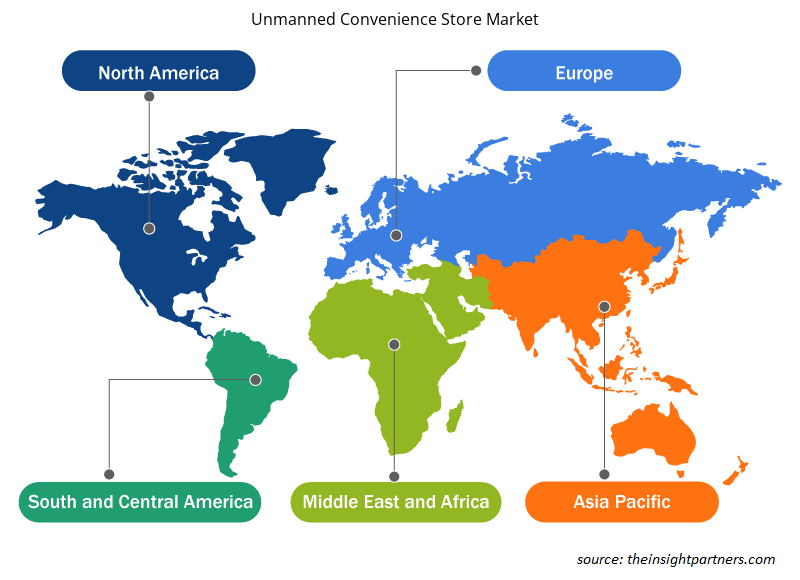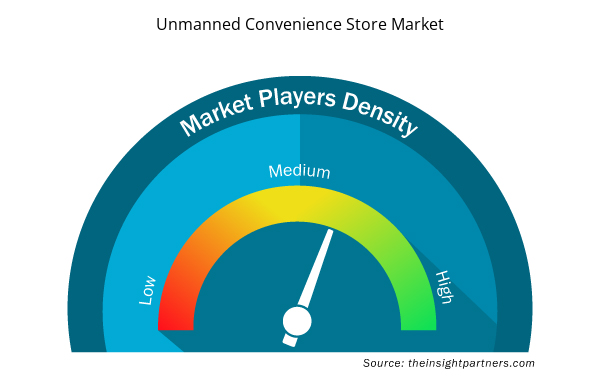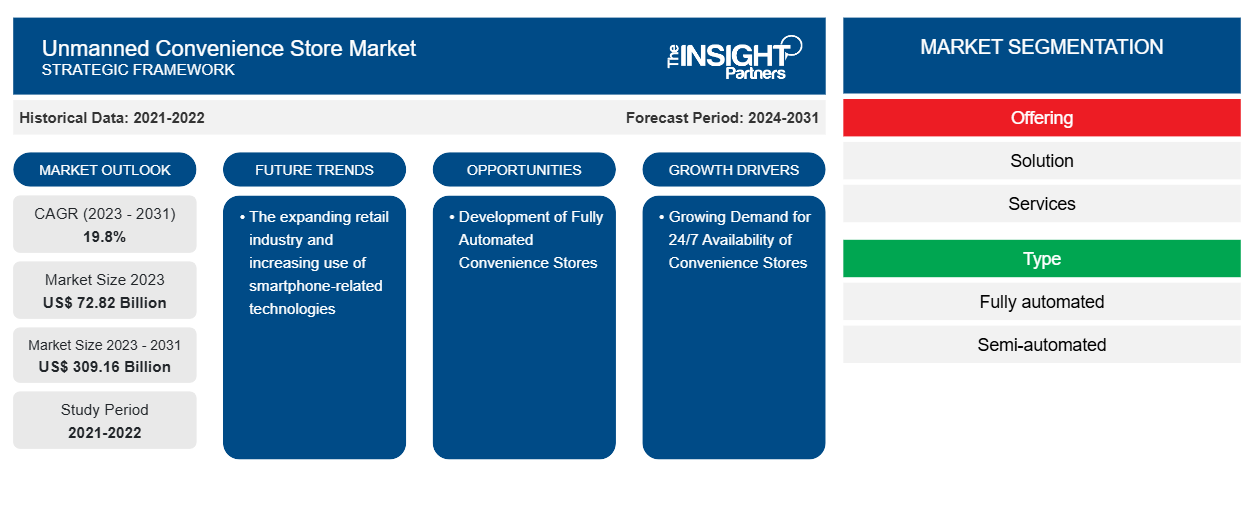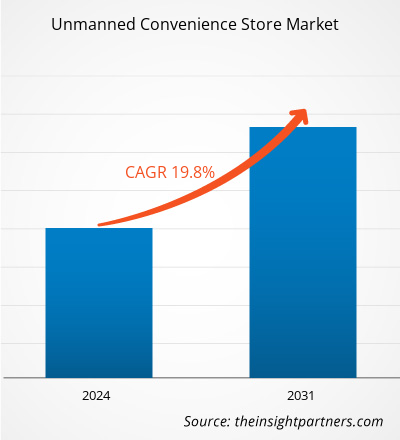Der Markt für unbemannte Convenience Stores soll von 72,82 Milliarden US-Dollar im Jahr 2023 auf 309,16 Milliarden US-Dollar im Jahr 2031 anwachsen. Der Markt soll zwischen 2023 und 2031 eine durchschnittliche jährliche Wachstumsrate (CAGR) von 19,8 % verzeichnen. Der expandierende Einzelhandel und die zunehmende Nutzung von Smartphone-Technologien dürften weiterhin wichtige Trends auf dem Markt für unbemannte Convenience Stores bleiben.
Marktanalyse für unbemannte Convenience Stores
Der Markt für unbemannte Convenience Stores wächst rasant, da die Nachfrage nach 24/7-Verfügbarkeit von Convenience Stores und die Nachfrage der Verbraucher nach Einkaufskomfort steigen. Der Markt wächst stetig, angetrieben durch den steigenden Bedarf der Unternehmen an Kostenoptimierung durch Verbesserung des Kundenerlebnisses. Darüber hinaus bieten technologische Fortschritte und die Entwicklung vollautomatischer Convenience Stores lukrative Möglichkeiten für Marktwachstum.
Marktübersicht für unbemannte Convenience Stores
Ein unbemannter Convenience Store ist eine Art Einzelhandelsgeschäft, das ohne Kassierer auskommt und in dem kein Kundendienstpersonal physisch anwesend ist. Diese Geschäfte nutzen moderne Technologien wie künstliche Intelligenz und Smartphone-Technologie, um tägliche Aktivitäten und Transaktionen abzuwickeln. Ein unbemannter Convenience Store soll es den Verbrauchern ermöglichen, schnelllebige Waren wie Lebensmittel oder Drogeriebedarf jederzeit und überall bequem zu kaufen. Diese Geschäfte bieten jedoch erhebliche Vorteile, wie 24/7-Verfügbarkeit, Bequemlichkeit, technologische Integration, Selbstbedienung und Selbstkasse sowie Kosteneinsparungen sowohl für Dienstleister als auch für Verbraucher, was den Markt antreibt.
Passen Sie diesen Bericht Ihren Anforderungen an
Sie erhalten kostenlos individuelle Anpassungen an jedem Bericht, einschließlich Teilen dieses Berichts oder einer Analyse auf Länderebene, eines Excel-Datenpakets sowie tolle Angebote und Rabatte für Start-ups und Universitäten.
- Holen Sie sich die wichtigsten Markttrends aus diesem Bericht.Dieses KOSTENLOSE Beispiel umfasst eine Datenanalyse von Markttrends bis hin zu Schätzungen und Prognosen.
Markttreiber und Chancen für unbemannte Convenience Stores
Wachsende Nachfrage nach 24/7-Verfügbarkeit von Convenience Stores treibt den Markt an
Die globale Branche der unbemannten Convenience Stores wächst aufgrund des wachsenden Bedarfs an Komfort und verbesserter Kundenerfahrung. Kunden möchten jederzeit Zugang zu Produkten und Dienstleistungen haben, ohne sich in lange Warteschlangen einreihen oder in ein Ladengeschäft gehen zu müssen. Dies erhöht die Nachfrage und Entwicklung unbemannter Convenience Stores, um die Nachfrage der Verbraucher zu befriedigen. Unbemannte Convenience Stores ermöglichen den Verbrauchern rund um die Uhr Zugang zu Waren und Dienstleistungen, ohne dass ein Mitarbeiter vor Ort sein muss, um diese Nachfrage zu decken. Ein unbemannter Store ist für Unternehmen eine finanziell vorteilhafte Wahl, da er die Kosten für das Personal senkt. Diese Faktoren werden den Markt im Prognosezeitraum voraussichtlich ankurbeln.
Entwicklung vollautomatischer Convenience Stores – eine Chance auf dem Markt unbemannter Convenience Stores
Die zunehmende Digitalisierung und die gestiegene Nachfrage nach Autonomie bei Unternehmen schaffen Chancen auf dem Markt. Unternehmen, die autonome Abläufe nutzen, können Arbeitskosten sparen, indem sie die physische Anwesenheit von Mitarbeitern im Geschäft vermeiden. Dadurch können sich Unternehmen auf andere Bereiche konzentrieren, wie etwa Werbung, Produktwerbung und Kundenbetreuung. Durch die Automatisierung können unbemannte Convenience Stores Sicherheitsrisiken und Versicherungskosten senken. Die wachsende Nachfrage und Entwicklung vollautomatischer Convenience Stores, die nicht anfällig für Diebstahl oder Beschädigung sind, bieten jedoch erhebliche Chancen für das Marktwachstum.
Segmentierungsanalyse des Marktberichts für unbemannte Convenience Stores
Wichtige Segmente, die zur Ableitung der Marktanalyse für unbemannte Convenience Stores beigetragen haben, sind Angebot und Typ.
- Basierend auf dem Angebot ist der Markt für unbemannte Convenience Stores in Lösungen und Dienstleistungen unterteilt. Das Lösungssegment hatte im Jahr 2023 einen größeren Marktanteil.
- In Bezug auf den Typ wird der Markt für unbemannte Convenience Stores in vollautomatische und halbautomatische unterteilt. Das vollautomatische Segment hatte im Jahr 2023 einen größeren Marktanteil.
Unbemannte Convenience Store Marktanteilsanalyse nach Geografie
Der geografische Umfang des Marktberichts für unbemannte Convenience Stores ist hauptsächlich in fünf Regionen unterteilt: Nordamerika, Asien-Pazifik, Europa, Naher Osten und Afrika sowie Südamerika/Süd- und Mittelamerika.
In Bezug auf den Umsatz hatte der nordamerikanische Markt den größten Marktanteil an unbemannten Convenience Stores, was auf den wachsenden Bedarf an kontaktlosen Einkaufserlebnissen und Komfort zurückzuführen ist. Der Markt in Nordamerika wird durch den zunehmenden Einsatz von Roboter- und künstlichen Intelligenztechnologien zur Automatisierung des Bezahlvorgangs angetrieben. Darüber hinaus erleichtert die Verfügbarkeit mobiler Zahlungsmethoden den Verbrauchern das Einkaufen ohne Interaktion mit einer Kassiererin, was den Markt ankurbelt.
Regionale Einblicke in den Markt für unbemannte Convenience Stores
Die regionalen Trends und Faktoren, die den Markt für unbemannte Convenience Stores während des gesamten Prognosezeitraums beeinflussen, wurden von den Analysten von Insight Partners ausführlich erläutert. In diesem Abschnitt werden auch die Marktsegmente und die Geografie für unbemannte Convenience Stores in Nordamerika, Europa, im asiatisch-pazifischen Raum, im Nahen Osten und Afrika sowie in Süd- und Mittelamerika erörtert.

- Erhalten Sie regionale Daten zum Markt für unbemannte Convenience Stores
Umfang des Marktberichts über unbemannte Convenience Stores
| Berichtsattribut | Details |
|---|---|
| Marktgröße im Jahr 2023 | 72,82 Milliarden US-Dollar |
| Marktgröße bis 2031 | 309,16 Milliarden US-Dollar |
| Globale CAGR (2023 - 2031) | 19,8 % |
| Historische Daten | 2021-2022 |
| Prognosezeitraum | 2024–2031 |
| Abgedeckte Segmente | Durch das Angebot
|
| Abgedeckte Regionen und Länder | Nordamerika
|
| Marktführer und wichtige Unternehmensprofile |
|
Dichte der Marktteilnehmer für unbemannte Convenience Stores: Auswirkungen auf die Geschäftsdynamik verstehen
Der Markt für unbemannte Convenience Stores wächst rasant, angetrieben durch die steigende Nachfrage der Endnutzer aufgrund von Faktoren wie sich entwickelnden Verbraucherpräferenzen, technologischen Fortschritten und einem größeren Bewusstsein für die Vorteile des Produkts. Mit steigender Nachfrage erweitern Unternehmen ihr Angebot, entwickeln Innovationen, um die Bedürfnisse der Verbraucher zu erfüllen, und nutzen neue Trends, was das Marktwachstum weiter ankurbelt.
Die Marktteilnehmerdichte bezieht sich auf die Verteilung von Firmen oder Unternehmen, die in einem bestimmten Markt oder einer bestimmten Branche tätig sind. Sie gibt an, wie viele Wettbewerber (Marktteilnehmer) in einem bestimmten Marktraum im Verhältnis zu seiner Größe oder seinem gesamten Marktwert präsent sind.
Die wichtigsten Unternehmen auf dem Markt für unbemannte Convenience Stores sind:
- Amazon.com, Inc.
- Shenzhen Rakinda Technologie Co., Ltd.
- F5 Future Store
- BingoBox
- CYB-ORG
- 7-Eleven Shop & Go
Haftungsausschluss : Die oben aufgeführten Unternehmen sind nicht in einer bestimmten Reihenfolge aufgeführt.

- Erhalten Sie einen Überblick über die wichtigsten Akteure auf dem Markt für unbemannte Convenience Stores
Marktnachrichten und aktuelle Entwicklungen für unbemannte Convenience Stores
Der Markt für unbemannte Convenience Stores wird durch die Erhebung qualitativer und quantitativer Daten nach Primär- und Sekundärforschung bewertet, die wichtige Unternehmensveröffentlichungen, Verbandsdaten und Datenbanken umfasst. Im Folgenden finden Sie eine Liste der Entwicklungen auf dem Markt für unbemannte Convenience Stores und Strategien:
- Im Februar 2024 plant 7-Eleven Shop & Go die Eröffnung eines unbemannten Convenience Stores in Tokio und anderen Gegenden. Diese unbemannten Convenience Stores werden mit Smartphone-Zahlungen betrieben, um den Betrieb zu rationalisieren. (Quelle: Nikkei Inc., Pressemitteilung, 2023)
Marktbericht zu unbemannten Convenience Stores – Umfang und Ergebnisse
Der Bericht „Marktgröße und Prognose für unbemannte Convenience Stores (2021–2031)“ bietet eine detaillierte Analyse des Marktes, die die folgenden Bereiche abdeckt:
- Marktgröße und Prognose auf globaler, regionaler und Länderebene für alle wichtigen Marktsegmente, die im Rahmen des Projekts abgedeckt sind
- Marktdynamik wie Treiber, Beschränkungen und wichtige Chancen
- Wichtige Zukunftstrends
- Detaillierte PEST/Porters Five Forces- und SWOT-Analyse
- Globale und regionale Marktanalyse mit wichtigen Markttrends, wichtigen Akteuren, Vorschriften und aktuellen Marktentwicklungen
- Branchenlandschaft und Wettbewerbsanalyse, einschließlich Marktkonzentration, Heatmap-Analyse, prominenten Akteuren und aktuellen Entwicklungen
- Detaillierte Firmenprofile
- Historische Analyse (2 Jahre), Basisjahr, Prognose (7 Jahre) mit CAGR
- PEST- und SWOT-Analyse
- Marktgröße Wert/Volumen – Global, Regional, Land
- Branche und Wettbewerbsumfeld
- Excel-Datensatz



Report Coverage
Revenue forecast, Company Analysis, Industry landscape, Growth factors, and Trends

Segment Covered
This text is related
to segments covered.

Regional Scope
North America, Europe, Asia Pacific, Middle East & Africa, South & Central America

Country Scope
This text is related
to country scope.
Häufig gestellte Fragen
The incremental growth expected to be recorded for the global unmanned convenience store market during the forecast period is US$ 236.34 billion.
The global unmanned convenience store market is expected to reach US$ 309.16 billion by 2031.
The key players holding majority shares in the global unmanned convenience store market are Appen Limited, CloudFactory Limited, Cogito, Keylabs.ai LTD, and Google LLC.
The expanding retail industry and increasing use of smartphone-related technologies to play a significant role in the global unmanned convenience store market in the coming years.
The growing demand for 24/7 availability of convenience stores and increasing demand for shopping convenience among consumers are the major factors that propel the global unmanned convenience store market.
The global unmanned convenience store market was estimated to be US$ 72.82 billion in 2023 and is expected to grow at a CAGR of 19.8% during the forecast period 2023 - 2031.
Trends and growth analysis reports related to Technology, Media and Telecommunications : READ MORE..
The Insight Partners performs research in 4 major stages: Data Collection & Secondary Research, Primary Research, Data Analysis and Data Triangulation & Final Review.
- Data Collection and Secondary Research:
As a market research and consulting firm operating from a decade, we have published and advised several client across the globe. First step for any study will start with an assessment of currently available data and insights from existing reports. Further, historical and current market information is collected from Investor Presentations, Annual Reports, SEC Filings, etc., and other information related to company’s performance and market positioning are gathered from Paid Databases (Factiva, Hoovers, and Reuters) and various other publications available in public domain.
Several associations trade associates, technical forums, institutes, societies and organization are accessed to gain technical as well as market related insights through their publications such as research papers, blogs and press releases related to the studies are referred to get cues about the market. Further, white papers, journals, magazines, and other news articles published in last 3 years are scrutinized and analyzed to understand the current market trends.
- Primary Research:
The primarily interview analysis comprise of data obtained from industry participants interview and answers to survey questions gathered by in-house primary team.
For primary research, interviews are conducted with industry experts/CEOs/Marketing Managers/VPs/Subject Matter Experts from both demand and supply side to get a 360-degree view of the market. The primary team conducts several interviews based on the complexity of the markets to understand the various market trends and dynamics which makes research more credible and precise.
A typical research interview fulfils the following functions:
- Provides first-hand information on the market size, market trends, growth trends, competitive landscape, and outlook
- Validates and strengthens in-house secondary research findings
- Develops the analysis team’s expertise and market understanding
Primary research involves email interactions and telephone interviews for each market, category, segment, and sub-segment across geographies. The participants who typically take part in such a process include, but are not limited to:
- Industry participants: VPs, business development managers, market intelligence managers and national sales managers
- Outside experts: Valuation experts, research analysts and key opinion leaders specializing in the electronics and semiconductor industry.
Below is the breakup of our primary respondents by company, designation, and region:

Once we receive the confirmation from primary research sources or primary respondents, we finalize the base year market estimation and forecast the data as per the macroeconomic and microeconomic factors assessed during data collection.
- Data Analysis:
Once data is validated through both secondary as well as primary respondents, we finalize the market estimations by hypothesis formulation and factor analysis at regional and country level.
- Macro-Economic Factor Analysis:
We analyse macroeconomic indicators such the gross domestic product (GDP), increase in the demand for goods and services across industries, technological advancement, regional economic growth, governmental policies, the influence of COVID-19, PEST analysis, and other aspects. This analysis aids in setting benchmarks for various nations/regions and approximating market splits. Additionally, the general trend of the aforementioned components aid in determining the market's development possibilities.
- Country Level Data:
Various factors that are especially aligned to the country are taken into account to determine the market size for a certain area and country, including the presence of vendors, such as headquarters and offices, the country's GDP, demand patterns, and industry growth. To comprehend the market dynamics for the nation, a number of growth variables, inhibitors, application areas, and current market trends are researched. The aforementioned elements aid in determining the country's overall market's growth potential.
- Company Profile:
The “Table of Contents” is formulated by listing and analyzing more than 25 - 30 companies operating in the market ecosystem across geographies. However, we profile only 10 companies as a standard practice in our syndicate reports. These 10 companies comprise leading, emerging, and regional players. Nonetheless, our analysis is not restricted to the 10 listed companies, we also analyze other companies present in the market to develop a holistic view and understand the prevailing trends. The “Company Profiles” section in the report covers key facts, business description, products & services, financial information, SWOT analysis, and key developments. The financial information presented is extracted from the annual reports and official documents of the publicly listed companies. Upon collecting the information for the sections of respective companies, we verify them via various primary sources and then compile the data in respective company profiles. The company level information helps us in deriving the base number as well as in forecasting the market size.
- Developing Base Number:
Aggregation of sales statistics (2020-2022) and macro-economic factor, and other secondary and primary research insights are utilized to arrive at base number and related market shares for 2022. The data gaps are identified in this step and relevant market data is analyzed, collected from paid primary interviews or databases. On finalizing the base year market size, forecasts are developed on the basis of macro-economic, industry and market growth factors and company level analysis.
- Data Triangulation and Final Review:
The market findings and base year market size calculations are validated from supply as well as demand side. Demand side validations are based on macro-economic factor analysis and benchmarks for respective regions and countries. In case of supply side validations, revenues of major companies are estimated (in case not available) based on industry benchmark, approximate number of employees, product portfolio, and primary interviews revenues are gathered. Further revenue from target product/service segment is assessed to avoid overshooting of market statistics. In case of heavy deviations between supply and demand side values, all thes steps are repeated to achieve synchronization.
We follow an iterative model, wherein we share our research findings with Subject Matter Experts (SME’s) and Key Opinion Leaders (KOLs) until consensus view of the market is not formulated – this model negates any drastic deviation in the opinions of experts. Only validated and universally acceptable research findings are quoted in our reports.
We have important check points that we use to validate our research findings – which we call – data triangulation, where we validate the information, we generate from secondary sources with primary interviews and then we re-validate with our internal data bases and Subject matter experts. This comprehensive model enables us to deliver high quality, reliable data in shortest possible time.


 Holen Sie sich ein kostenloses Muster für diesen Bericht
Holen Sie sich ein kostenloses Muster für diesen Bericht